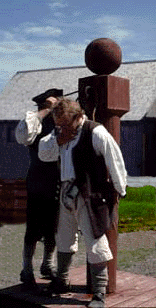
Punishment

What forms of punishment were in store for those who committed crimes in the 18th century? This is a question historians ponder as they investigate historical sources. Deviant behaviour was not tolerated in the town of Louisbourg. Court records provide us with a fairly accurate analysis of societal norms and disapproval's of behaviour in the 18th century.
Depending on the seriousness of an offense, sentences ranged from torture and execution to a small fine. Executions and judicial torture were implemented for the most serious crimes. Some criminals found guilty of a serious crime might be banished from the colony, sent to serve life on the galleys of France, branded on the hand or shoulder, or pardoned.
A fine was the simplest form of punishment for inappropriate behaviour. For instance, Pierre LeBlanc was fined 10 livres for making a wrongful accusation. Thérèse Petit was compelled to pay a fine of 3 livres to the court and 30 livres to the poor for acting disrespectful to the council. Apology and restitution to the injured party were sometimes required in civil disputes.
The most common form of punishment in the military was incarceration in the prison. Short sentences were given to soldiers who might have returned to the barracks after curfew, failed to appear for drills or duties, fought in the barracks, acted disrespectful towards an officer, sold or lost articles on their uniform, and/or became intoxicated. The courts did not issue long prison sentences because serious offenders would simply be banished from the colony and returned to France. Another form of banishment was deportation to the galleys of France. In this instance, convicts would be sent to serve life sentences as slaves in the Mediterranean fleet.
Prisons were also used for detaining suspects before and during criminal trials. These prisons were primarily located in the King's Bastion barracks and the guardhouse at the Maurepas Gate. After 1749, more prisons were created in the Queen's Gate guardhouse and two King's Bastion casements.
 A variety of physical punishments were inflicted upon an convict. Punishment was usually administered in a public place. The public scorn and humiliation of an offender reinforced judicial punishment. The mildest physical punishment was known as the "Carcan" or pillory in Place du Port. An individual was attached to a wooden pole by an iron ring around the throat, while the hands were confined by shackles, ropes, or handcuffs. For instance, Nicolas Casteloir was sentenced to three hours in the carcan for stealing a fishing shallop. Other forms of punishment involved whipping, branding, and hanging. Criminals were sometimes forced to wear a symbol in public representing the atrocious crime they committed.
A variety of physical punishments were inflicted upon an convict. Punishment was usually administered in a public place. The public scorn and humiliation of an offender reinforced judicial punishment. The mildest physical punishment was known as the "Carcan" or pillory in Place du Port. An individual was attached to a wooden pole by an iron ring around the throat, while the hands were confined by shackles, ropes, or handcuffs. For instance, Nicolas Casteloir was sentenced to three hours in the carcan for stealing a fishing shallop. Other forms of punishment involved whipping, branding, and hanging. Criminals were sometimes forced to wear a symbol in public representing the atrocious crime they committed.
The "Wooden Horse" was a raised trestle accompanied by an uncomfortable seat for a soldier. The culprit would be forced to sit on it for a length of time with eight pound muskets dangling from his ankles.
 Troublesome behaviour accompanied by drunkenness and petty theft were usually an excuse for punishing a soldier on the wooden horse in public.
Troublesome behaviour accompanied by drunkenness and petty theft were usually an excuse for punishing a soldier on the wooden horse in public.
The favorite method of corporal punishment was known as "les verges" or flogging. An individual was forced to run the gauntlet between two lines of soldiers who would beat him with sticks as he passed by them. Judicial torture was sometimes needed to obtain information from the accomplice such as threatening the offender with a hot poker. However, judicial torture was recommended only when there was overwhelming evidence of guilt.
Finally, the higher court would issue capital punishment for severe crimes such as robbery, desertion, murder, etc. Execution was implemented only when there was an immense amount of evidence which proved guilt beyond a doubt. The life sentence was usually carried out the day it was handed down. In the event of execution, there was an individual known as an interrogator whose role was to question the accused and obtain confessions of guilt and information on possible accomplices. The criminal might have been ordered to ask God for forgiveness before he was punished. The entire garrison would usually assemble to witness the execution.
Capital punishment had degrees of severity. Some individuals were shot, hung on gallows, dismembered after death, or left to hang for a long period of time after death. Bernard Darospide dit Detchepart, convicted murderer, experienced an atrocious death by having his arms, legs, thighs, and neck broken while alive and then placed by the carcan.
Punishment was a necessary device in French society in order to maintain an orderly way of life for the citizens of Louisbourg. A great deal of attention is focused on today's justice system and the effectiveness of our prisons in rehabilitating offenders. How have we improved prison conditions and the rehabilitation process over the centuries?


